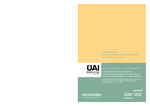The Hyksos Ruler Khyan and the Early Second Intermediate Period in Egypt: Problems and Priorities of Current Research
Proceedings of the Workshop of the Austrian Archaeological Institute and the Oriental Institute of the University of Chicago, Vienna, July 4 – 5, 2014
Contributor(s)
Forstner-Müller, Irene (editor)
Collection
Austrian Science Fund (FWF)Language
EnglishAbstract
Recent results from the most important sites of the Late Middle Kingdom and the Second Intermediate Period (Edfu, Tell el-Dab'a and Abydos) have broadened our knowledge of the situation in Egypt enormously. Of utmost importance in this context are the sealing impressions from Edfu and Tell el-Dab’a bearing the name of the Hyksos ruler Khyan and the discovery of the previously-unknown royal tombs of an independent „Abydene” Dynasty in Abydos, which bring new light to bear on our understanding of the political situation in this period.
Besides King Apophis, Khyan is one of the most important kings of the 15th Dynasty. However, his chronological position within the 15th Dynasty is not clear. Traditionally he has been assigned to the middle of the 15th Dynasty, but recent results now indicate a dating at the beginning of the 15th Dynasty and an overlap between the 13th and the 15th Dynasty. This new chronological position has far-reaching consequences not only for Egyptian chronology, but also for the chronology of the Mediterranean world. The new finds from Tell el-Dab’a, Edfu and Abydos necessitate a revision of the chronology of Dynasties 13 to 17 in Egypt, and a reconsideration of political and administrative structures during the Second Intermediate Period.
The discussions during the workshop were very positive, although a wide range of interpretations of the evidence still remain plausible, especially in respect of the chronological conclusions. These are reflected in the range of contributions to the volume. It is hoped that this publication will stimulate further discussion and research on this important topic. Neue Forschungsergebnisse an den wichtigsten Fundplätzen des Endes des Mittleren Reiches und der Zweiten Zwischenzeit dieser Zeit (Edfu, Tell el-Dab'a und Abydos) haben unser Verständnis der Situation Ägypens in dieser Epoche beträchtlich erweitert. Von besonderem Interesse in diesem Zusammenhang sind die in Edfu und Tell el-Dab’a gefundenen Siegelabdrücke mit den Namen des Hyksoskönigs Khyan und die Entdeckung der bisher unbekannten königlichen Gräber einer unabhängigen „Abydenischen“ Dynastie in Abydos, die zum Verständnis der politischen Situation dieser Zeit beitragen.
Neben König Apophis ist Khayan einer der bedeutendsten Könige der 15. Dynastie. Dennoch ist seine chronologische Stellung innerhalb der 15. Dynastie nicht bekannt. Traditionellerweise wurde dieser Herrscher bisher in die Mitte der 15. Dynastie gesetzt, die neuen Forschungsergebnisse erlauben jetzt eine Datierung an den Beginn dieser Dynastie und somit eine Überlappung der 13. und 15. Dynastie. Diese neue zeitliche Einordnung hat weitreichende Folgen nicht nur für die ägyptische Chronologie, sondern darüber hinaus auch für die Chronologie des Mittelmeerraums. Die neuen Funde aus Tell el-Dab’a, Edfu und Abydos erfordern eine Revision der Chronologie der 13. -17. Dynastien in Ägypten. Darüber hinaus wurde der Versuch der Rekonstruktion der politischen und administrativen Situation der Zweiten Zwischenzeit unternommen.
Die Diskussionen während des Workshops waren sehr konstruktiv, dennoch blieb eine Bandbreite an Interpretationen, insbesondere in Bezug auf die chronologischen Schlussfolgerungen, wie in den verschiedenen Beiträgen ersichtlich ist. Die Publikation bringt eine Auswahl an verschiedenen Gesichtspunkten und Analysen innerhalb der Regierung des Hyksoskönigs Khyan und darüber hinaus mit der Zielsetzung, weitere Diskussion und zukünftige Forschung zu bisher ungelösten Fragen zu stimulieren.
Keywords
Ancient Egypt, Hyksos, Chronology, King Khyan; Altes Ägypten, Hyksos, 2. Zwischenzeit, Chajan, ChronologieDOI
10.15661/mono/arch/hyksos.ruler.khyanISBN
9783902976833OCN
1051778662Publisher
HolzhausenPublisher website
https://www.verlagholzhausen.at/Publication date and place
2018Grantor
Classification
History
Archaeology


 Download
Download